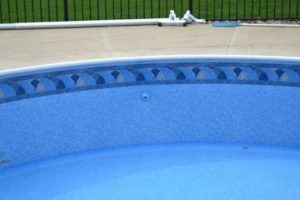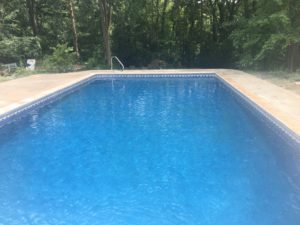
Vinyl liner pools have been around for over half a century. Traditional vinyl liner pools have been known as “packaged” pools, because they are often prefabricated, and arrive on site in a package complete with all the necessary components.
The liners are made of heavy gauge vinyl, typically 20mm or more in thickness. Liners are carefully manufactured to precisely fit the shape of the pool, and can be custom made to fit even the most elaborate pool shapes. The wall panels are often made of steel, wood, or composites. The bottom of the pool is often a sand, vermiculite, or concrete mix.
Vinyl Liner Pool PROS
- Low Cost: Vinyl liner pools are typically the least expensive of the three. While fiberglass may have less labor involved, shipping costs tend to elevate the cost of a fiberglass pool above that
 of a liner; with gunite typically thought of as the most expensive.
of a liner; with gunite typically thought of as the most expensive. - Maintenance: Vinyl’s smooth surface makes it easy to fight an algae bloom, if one may happen to break out.
- Soft To Walk In: While gunite pools are often known for “pool toe” (or sore feet) and fiberglass pools have a hard shell, soft vinyl will typically have a soft underlayment on the floor. Such as sand or vermiculite (a spongy, porous concrete).
- Customize: Since a vinyl pool is constructed on site, the builder does have the ability to modify the depth and even the shape, if need be.
Vinyl Liner Pool CONS
- Durability: While the structure of a vinyl pool tends to last decades without any issues, the liner tends to need to be replaced about every 7-15 years.
- Leaks: While today’s liners are strong, a broken bottle or nail falling into the pool could result in some unnecessary water loss by poking holes or tearing a liner.
- Slippery: If water chemistry is not monitored or an algae blooms occurs, vinyl can be a very slippery surface.

